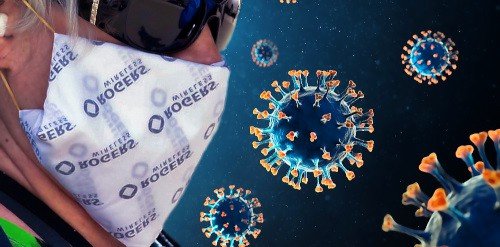By Andy Kramek, April 21, 2020
Let me emphasize that I am not a doctor, nor am I am a virologist or epidemiologist. However, I do have degrees in microbiology and chemistry so I do understand a little more of the underlying issues.
There is much controversy around, and conflicting advice abounds, about the wearing of personal protective equipment (PPE) – especially masks. It is important to stress that there are huge differences between medical-grade respirator masks and the homemade, improvised masks that are widely available. It has been suggested that, even if an improvised mask will not stop you catching the virus, it can help prevent spreading and therefore should be worn, or that it reminds you not to touch your face.
However, the danger in this view, as we have already seen, is that people think they are safe because they are wearing a home-made mask. As a result, they tend to ignore the precautions that do keep them safe. Maintaining proper distance in public, and practicing good hygiene, are far more important than wearing a mask whose holes are more than 60 times larger than the virus particles. Even an N95 mask will catch only 95% of virus sized particles (which is why medical staff who know how to wear them, and how to use them, can still get infected). Improvised masks are totally ineffective from a medical perspective because, even though they may hinder the spread of droplets, they will not prevent the passage of free virus particles that are shed from mucous membranes when you sneeze or cough.
However, there are a number of other well-documented issues associated with wearing improvised masks – especially for long periods. First, bacteria, mucus, and dirt get caught in your mask when you breathe out. Then, when you breathe in, you re-inhale them. It’s like blowing your nose in a handkerchief and wearing it all day on your face!
Second, when wearing a mask about 30% of the exhaled CO2 from your lungs is drawn back into your lungs with each new breath. Inhaling CO2 mixed with fresh air results in a depleted oxygen mixture that passes into the blood in the alveoli. The presence of such dissolved CO2 in the blood causes mild hypoxia; reflexes and reactions slow down, and senses are dulled. So when driving you should definitely remove your mask.
Third, an additional effect occurs when people use masks that, effectively, force extra CO2 into their bodies. The excess CO2 in the lungs dissolves in pulmonary fluid producing carbonic acid which then diffuses into the blood. The result is that the acid causes blood pH to fall (blood acidosis). The body responds with compensatory mechanisms to reduce blood acidity, especially widening arteries and closing down less important veins and capillaries. The consequences are not normally serious, and are transitory, but can result in a feeling of light-headedness or mild dizziness.
All of the above are multiplied when the wearer has underlying respiratory issues – COPD, pneumonia, chronic bronchitis or asthma or a compromised immune system. However, many other medical conditions make individuals more susceptible to both hypoxia and acidosis, including diabetes and obesity.
The bottom line is that there are certainly people who need, for medical reasons, to wear masks when out in public. Such people should be getting proper medical grade masks and not be relying on improvised face cloths.
For the rest of us, the most important thing to do is to maintain your distance when in public, and practice good hygiene at all times. By all means, wear a mask if you feel it helps you, but be aware of the issues associated with doing so.
By Andrew Kramek, April 21, 2020
***
Thank you for reading. Be sure to bookmark this website so you don’t miss any updates.
Click here to visit our Private Facebook Group












Monica Impellizzeri
04/21/2020 — 2:56 pm
Thank you! I am in total agreement with this! I have not been wearing a mask and probably won’t. Nothing I’ve heard from the experts has convinced me that wearing a mask will keep me safe.
BTW I have no health issues and I do not take any medication. I also exercise routinely.
Tom Blakeman
04/21/2020 — 3:44 pm
Good info Andy. Thanks.
Dolores
04/21/2020 — 3:44 pm
Thank you. Excellent explanation. Too bad it is not what the so-called experts tell us. Bottom line is you should all do what is comfortable for you but understand that good hygiene is critical and masks are not.
Melinda Alvord
04/21/2020 — 4:52 pm
Mostly just wearing a mask for short trips in and out of a store because it serves as a reminder to me to keep my distance, avoid face touching, and handling things like door knobs, items on a store shelf, etc. Otherwise, it’s just obnoxious and uncomfortable for any extended use (and realization that I could never be in a profession that requires wearing a mask as part of my job!) Thanks for this informative write up.
Lewis Robinson
04/21/2020 — 4:52 pm
where do you get medical grade masks?
Andy Kramek
04/21/2020 — 6:21 pm
You can buy masks on-line (be aware though that delivery times could be significant) or, if you are in a high risk category, I would suggest that you contact your health provider directly. They will be able to advise you what type you need, and how and where to get them.
Walter Chance
04/21/2020 — 5:04 pm
Excellent explanation. I would also not recommend nitrile gloves. Having worked in an ER for 3 years as a volunteer, one must change gloves after entering a new room. Gloves spread bacteria and germs if worn too long or not changed constantly. Washing hands with warm water and soap for at least 20 seconds is far more effective. Unless your in a medical facility where boxes of gloves are readily available. Best to wash hands and use sanitizer where hand washing is not available.
Avoid offense
04/21/2020 — 7:19 pm
It was formerly voluntary, but now those in Connecticut are under governor’s orders to wear a mask of some sort in public. Nurses are litigating against the doctor they work with for sneezing on them. Someone punched an 85 year old woman for not keeping her distance, which caused her to have a stroke and die. Wear a mask or scarf for others’ peace of mind if not for your own. Just don’t touch it with contaminated hands.
Andy Kramek
04/23/2020 — 12:17 pm
Unfortunately, as I said in the article, people wearing masks tend to think they are “safe”. So they forget about maintaining distance, washing hands and generally practicing good hygiene. As if that is not bad enough, people do not know how to put them on and take them off without contaminating themselves. Let alone how to properly decontaminate and sanitize them after use.
Just this morning I was in a store and saw a lady who was wearing a mask come right up behind another person looking at items. She lifted up her mask by grabbing the front with her hand, said ‘excuse me’ and reached around the other person to get an item. She then patted her mask back into place and walked away – no doubt feeling she was perfectly safe and secure!
Also, as I said, by all means wear a mask if it makes you feel better, but please (if only for the safety of others) do not neglect distancing and good hygiene practices.
Frank Shears
04/22/2020 — 7:31 pm
Good explanation Andy. Thank you.